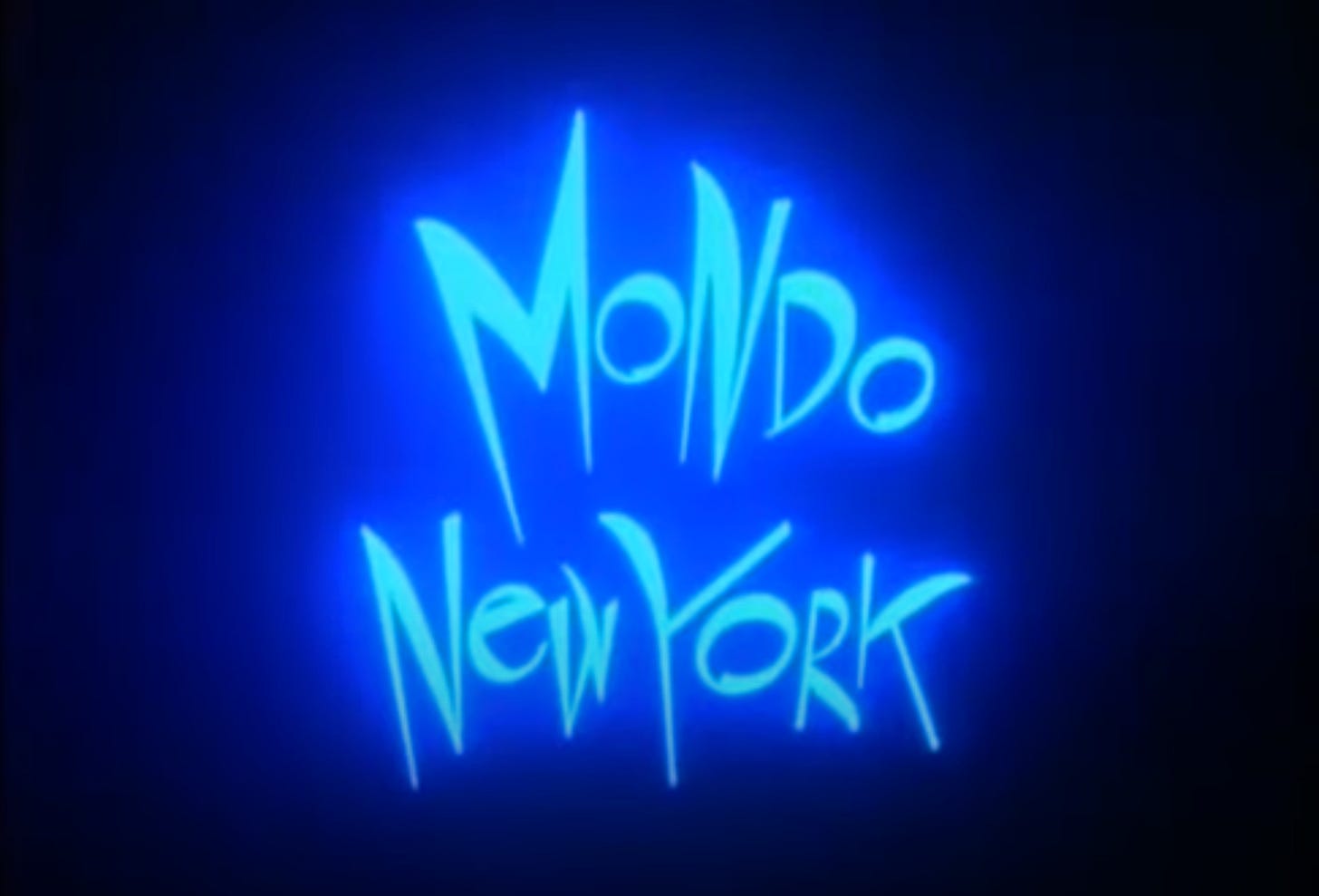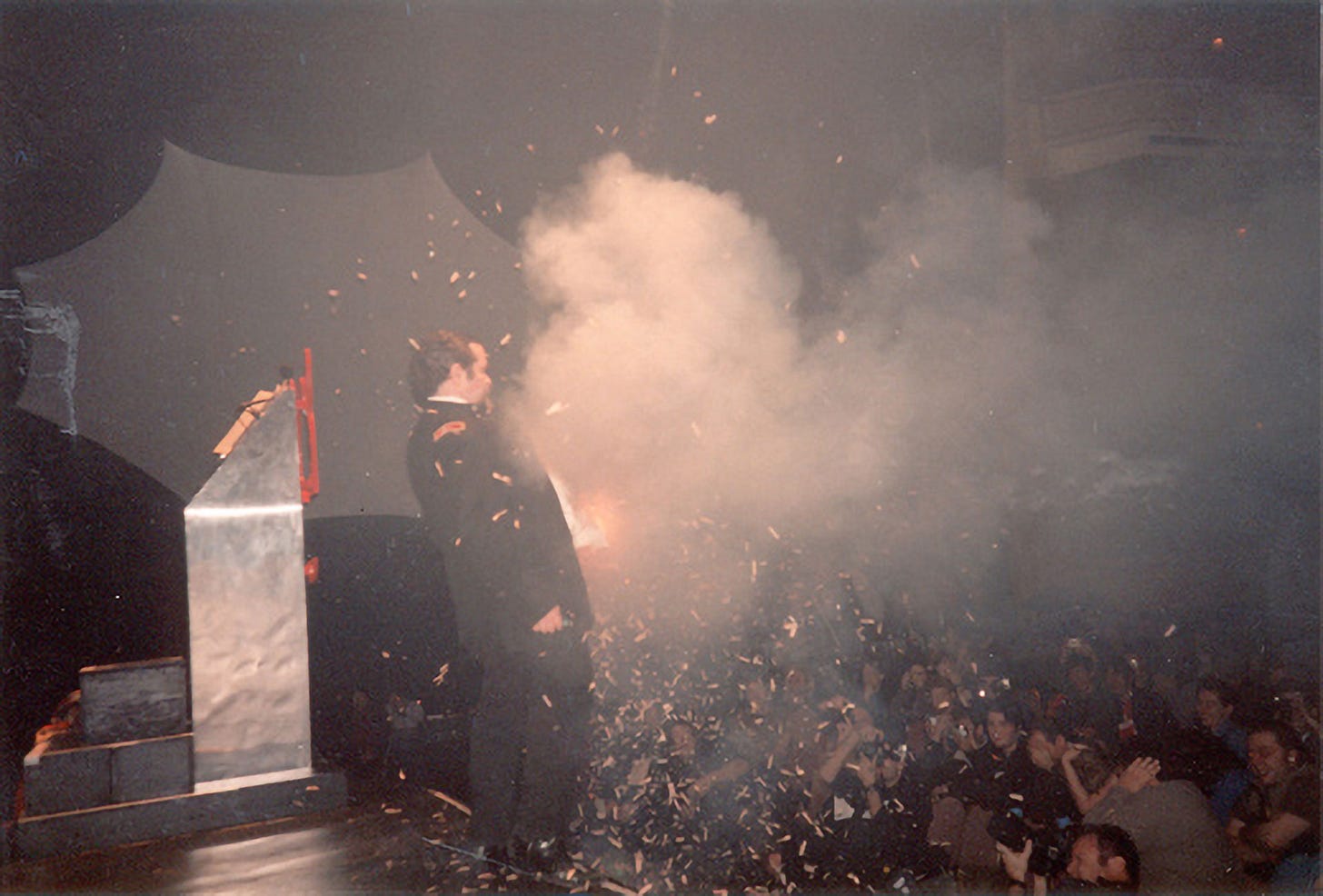Return to Mondo Kim’s
On Kim's Video and a recent screening of Mondo New York

A couple of weeks ago, I sat with one hundred people in a poorly air-conditioned room in downtown Manhattan to watch a VHS copy of Mondo New York (1988). The screening was the first in a series culled from the vast stock of the long-defunct Mondo Kim’s. For those readers not from New York or too young to remember, Mondo Kim’s sold and rented video (and audio) media on St. Mark’s Place in the East Village from 1995 to 2009. Founded by one Yongman Kim, Mondo was the mothership of the Kim’s Video empire, which started in Kim’s dry cleaning business in 1987 before expanding to several rental and sales locations. The video store on St. Mark’s was a cinephilic pleasuredome stocked with 55,000 VHS and DVD rental titles: bootleg French New Wave; deep-cut wuxia; ’60s experimental films; legendary concerts; rare arthouse; Turkish rip-offs of Hollywood films; and singular oddities like the Heaven’s Gate initiation tape. The stock was arranged by country, genre, and then director—the last category serving as a snobby barrier of entry for the casual customer who didn’t know William Wyler from Billy Wilder. A lot of the stock was bootlegged, often by Mr. Kim himself, and it was rumored that FBI anti-piracy brigades made frequent appearances.
For a few years in the mid-nineties my student life was triangulated between film classes with J. Hoberman and Robert Breer at the Cooper Union; the Essential Cinema screenings at Anthology Film Archives; and rentals from Kim’s, first on the corner on Second Avenue and St. Mark’s, and later down the block at Mondo. A hat trick day would have included watching something from all three, probably ending with me falling asleep in an uncomfortable seat at Anthology. Rentals would have been all VHS (and I assume some LaserDisc) until about the end of the decade when official and unofficial DVDs started appearing. The internet existed then, but it was without much of a film culture, so classrooms or Kim’s shelves were the only way one discovered anything new and cool. (The NYU on-site video library was also useful, though sanitized.) It wasn’t all bootlegs, either. For someone who grew up in rural America, officially released titles were often out of reach. Kim’s was the first place I could see “rare” classic American films, or even ’90s films that somehow didn’t make it to my local Blockbuster.
Unsurprisingly, regrettably, Mondo Kim’s closed in 2009. Kim’s last retail store closed a few years later. Since then, the rental stock has survived a roundtrip to Sicily, a bizarre story summarized best elsewhere. Those thousands of tapes recently landed in the basement of the Alamo Drafthouse, and now two former Kim’s employees, filmmakers Michael Bilandic and Sean Price Williams, are archiving it all. About a dozen of Kim’s infamously grumpy and opinionated staff have gone on to become directors and critics, including the critic Nick Pinkerton, the late Nick Zedd, and Joker director Todd Phillips. Plenty has been said about Kim’s: there was a screening program at Metrograph, and, most recently, a feature documentary. The archiving project echoes that of Kim’s West Coast spiritual sibling, Video Archives, staffed by then-unknown Quentin Tarantino and Roger Avery, both of whom now host a podcast devoted to watching a selection titles from that immense library.

Nostalgia often works best on those who weren’t there, and much of the room gathered to watch Mondo New York was too young to have ever rented a VHS tape. The film itself—a semi-documentary directed by Harvey Keith—is a look at downtown New York in the 1980s. Except for the producer, Stuart Shapiro, who was on hand to answer questions, I saw only two or three people old enough to have been adults in 1988.
As the night’s host, Bilandic, mentioned in his introduction, there is a higher quality version of the film online, with a 4K restoration on the way. But we were all there to watch the battered Kim’s VHS. As anticipated, and maybe even desired, the tape was so degraded that the sound was out of sync and the color had gone psychedelic. The screening revived in me the forgotten Kim’s one-two letdown of discovering a rare bootleg at the store only to have your hopes later dashed by an awful transfer. The screening illustrated something about media nostalgia: an interest in picture and audio fidelity are loosely correlated with watching dead media, despite what vinyl-heads or nitrate enthusiasts might tell you.
Mondo New York wasn’t an “official” mondo film, meaning it wasn’t made by filmmakers Paolo Cavara, Gualtiero Jacopetti and Franco Prosperi, the unholy trinity who made the original Mondo Cane in 1962. (The New York film also, obviously, had nothing to do with Mondo Kim’s, with which it only shares a leading adjective.) I don’t remember renting any mondo from Kim’s, but I have seen a lot of mondo films as preparation for a long essay I wrote on the subject in 2012, “Of Business and Pleasure.” (Published as part of my Documenta 13 book, A Report on the City). Mondo films were a disreputable brand of documentaries that focused on the prurient side of just about every (mostly non-Western) world culture. Mondo was sex, drugs, blood, boobs, weird food, “natives,” questionable medical practices, and varieties of nostalgie de la boue—basically a Vice travel documentary, but shot on 16mm. A good portion of it was made up, meaning it was staged, most often the violent parts. There were mondo films about modern slavery and magical practices and kinky sex. A number of spin-offs ensued, upping the ante on the sex and offensiveness, including the infamous Faces of Death series. It wasn’t all gutter stuff, either; Alberto Moravia wrote the voice-over for one mondo film and Peter Ustinov narrated another.
The downtown ’80s scene in Mondo New York offered an apt subject for the genre. Various remembered and forgotten performance artists make appearances, including a baby-faced Karen Finley. There’s a brief tour of some rough trade sex clubs. (Mondo New York got an X rating.) A section features two charming politically incorrect street comedians performing in Washington Square Park. Interspersed throughout are weirdo-on-the-street interviews. (“If you can’t make it in New York, you can’t make it anywhere.”) No fewer than three different live animals have their heads bitten off by performers. One performer is a Macumba shaman and the other is Joe Coleman. (The animals are a rooster and two mice, respectively.) True to the genre, there’s a lot of male-gazey shots of half-naked women, and there is one racist scene in which a Chinese patriarch auctions off his daughters to male bidders in an underground market. Of course, the Chinese scene was invented by the white filmmakers. According to the producer, Shapiro, the auction scene was the only one that was staged. (Excluding the film’s framing narrative of an out-of-town flaneuse wandering from spectacle to spectacle.)
Why the filmmakers invented that scene was not discussed, as there can be no good explanation. For most of the talk, Shapiro stuck mostly to the factual: how performers were found; the filmmaker’s own relation to the downtown scene; and how the film was later dumped by its parent company, which, if I remember correctly, was Warner Bros. The conversation then veered to the questionable idea that “this film couldn’t get made today.” But considering the film was dropped by the studio that produced it in 1988, the film almost didn’t get made then, either.
It’s true: they don’t make ‘em like that anymore. Although a few underground filmmakers are continuing the mondo tradition, the films are so marginal that one can safely declare the genre deceased. Mondo is dead, but not because of uptight right-wingers or priggish liberals. The reason, I suspect, is more counterintuitive. Mondo won. Mondo is mainstream, though it may feel like the opposite is true. To expand on a previous example, Vice Media, as the name implies, is pretty much the bastard child of mondo. Many Vice docuseries, like Hamilton Morris’s gonzo drug-themed travel show, are mondo in spirit. Even CNN-approved Anthony Bourdain was frequently mondo, as when he visited a tentacle porn creator and a shibari expert in an episode about Tokyo. It hardly gets more mondo than that.
As for how New York is portrayed today, little is forbidden, even on CNN. Bourdain’s posthumously released look at the Lower East Side in Parts Unknown included many of the same people that appear in Mondo New York—Lydia Lunch and Joe Coleman, for instance. Bourdain’s episode even appears to use footage of a Coleman performance taken directly from Mondo New York. (Minus mouse decapitations.) And if you think the underground culture in New York has been starched out by kaki-wearing gentrifiers, everything you see in Mondo New York can still be found here. YouTube and other, more adult video sites all offer proof.
If anything is finally being scrubbed from culture, it’s scenes like the film’s racist portrayal of Chinese life on the Lower East Side. It really is an awful choice on the part of the filmmakers, though it is genre-appropriate. As is obvious to anyone who has laid eyes on a mondo film, mondo was shot through with distorted imaginings of a non-white world, a largely fictional place populated with “savages” rendered inhuman and sexualized. Sometimes the whole affair was dressed up with a bogus world-weary political angle. (“Look how awful things are in Africa!”) Sometimes, no such bad faith was needed. Mondo chased the buzz of shockumentary thrills—thrills as conceived by white people for white people. That dreary project never completely dies.
Mondo is no more, and Kim’s is gone too. Kim’s closed for the same reasons all video stores closed: Netflix rentals first, streaming later. But one aspect of Kim’s has been absorbed into the general culture just as Mondo was. The kind of encyclopedic completeness a place like Kim’s offered can be found everywhere today, from Pirate Bay to YouTube. Even Amazon Prime and Tubi offer selections that Kim’s would have missed. And there’s no reason anymore to endure a picture so deteriorated that it no longer qualifies as representational. Every Z-grade film gets a 4K Blu-ray release today, replete with director’s commentaries and multiple documentary extras. It’s not a bad time to have an interest in obscure films, for sure. Happily, sleaze is not dead, and cinephilia has an afterlife beyond the video rental store.




